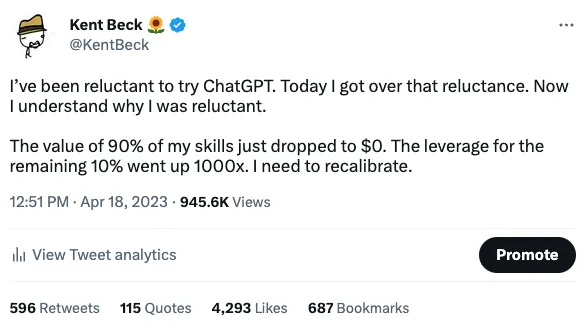With the rise of GenAI coding assistants, there’s been a lot of noise about the supposed decline of junior developer roles. Some argue that GenAI can now handle much of the grunt work juniors traditionally did, making them redundant. But this view isn’t just short-sighted – it’s wrong.
I’ve never heard a CTO say they hired junior developers to off load simple tasks to cheaper staff.
Organisations primarily hire junior devs as its seen as a cost effective way to grow their own talent and thus reduce reliance and dependency on external recruitment.
Yes, juniors start with less complex work, but if that’s all they did, they’d never develop into senior engineers – defeating the very purpose of hiring them.
But more than that, junior developers contribute far beyond just writing code, and if anything, GenAI only highlights just how valuable they really are.
Developers only spend a small amount of time coding
As I covered in this article, developers spend surprisingly little time coding. It’s a small part of the job. The real work is understanding problems, solving problems, designing solutions, collaborating with others, and making trade-offs. GenAI might be able to generate some code, but it doesn’t replace the thinking, the discussions, and the understanding that go into good software development.
Typing isn’t the bottleneck. I’ve written about this before, but to reiterate – coding is only one part of what developers do. The ability to work through problems, ask the right questions, and contribute to a team is far more valuable than raw coding speed and perhaps, even deep technical knowledge (go with boring common technology and this is less of a problem anyway).
If coding isn’t the bottleneck, and collaboration, problem-solving, and domain knowledge matter more, then the argument against juniors starts to fall apart.
What juniors bring to the table
One of the best examples I’ve seen of this was when we started our Technical Academy at 7digital. One of our first cohort came from our content ingestion team. They’d played around with coding when they were younger, but had never worked as a developer. From day one, they added value – not because they were churning out lines of code, but because they were inquisitive, challenged assumptions, and made the team think harder about their approach. They weren’t bogged down in the ‘this is how we do things’ mindset. (It also benefited they had great industry and domain knowledge, which meant they could connect technical decisions to real business impact in ways that even some of our experienced developers struggled with).
This is exactly what people often under-appreciate about junior developers. In the right environment, curiosity and problem-solving ability are far more important than years of experience. A good junior can:
- Ask the ‘stupid’ questions that expose gaps in understanding.
- Challenge established ways of working and provoke fresh thinking.
- Improve team communication simply by needing clear explanations.
- Bring insights from other disciplines or domains.
- Provide opportunities to mentor for other developers (to e.g. gain experience as a line manager/engineering manager)
- Grow into highly effective engineers who understand both the tech and the business.
GenAI doesn’t replace the learning process
GenAI might make some tasks easier, but it doesn’t replace the learning process that happens when someone grapples with real-world software development (one challenge, however, is ensuring junior devs don’t become over-reliant on GenAI and still develop fundamental problem-solving skills).
Good juniors add more value than we often realise. They bring energy, fresh perspectives, (and even sometimes, domain knowledge) that makes them valuable from day one. In the right environment, they’re not a cost – they’re an investment in better thinking, better collaboration, and ultimately, better software.
Rather than replacing junior developers, GenAI highlights why we need them more than ever. Fresh thinking, collaboration, and the ability to ask the right questions will always matter more than just getting code written.
And that’s precisely why juniors still matter.

